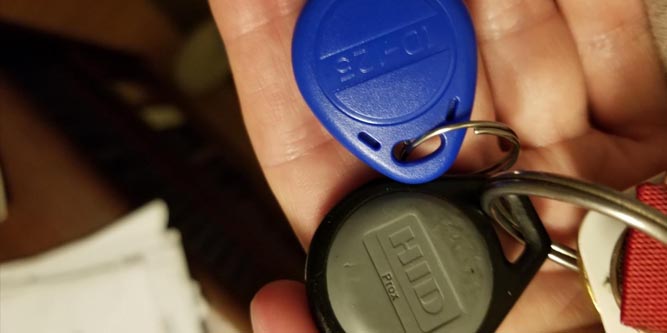These days, you can’t be too careful about security. But for doors that see a lot of traffic, physical keys aren’t always practical. For one thing, there’s the headache of waiting for the person in front of you to use a physical lock. For another thing, there’s the risk that a physical key could be easily copied. Those are just a couple of reasons that businesses have been turning to RFID tags and fobs. An RFID tag can be used in only a second, and is much easier than messing with a physical key. These tags are also not easy for the average person to copy. You need the right equipment, and a little bit of know-how.
That’s all well and good. But what happens when you need to make new fobs? Maybe you’re hiring more employees. Maybe you’re an educational institution, and you have a constant revolving door of students. Or maybe you need to provide access to maintenance or cleaning staff. Point being, the same security features that make key fobs so safe also makes them harder to duplicate. Thankfully, there are ways to duplicate any fob or card – if you have the right equipment.
Let’s be clear. There are many RFID fob brands and types, and not all can be duplicated with the same equipment. Some use encrypted technology, and you can only duplicate them with the correct brand of copier. In those cases, you’ll need to use the copier that’s provided by your manufacturer. That said, there are many unencrypted and partially-encrypted cards. In those cases, you can usually make a good copy with the right copier.
We’re about to review three of the best RFID key fob and card copiers. We’ll start out with the Keysy RFID Duplicator. This is a keychain-sized duplicator that can store up to four cards in memory. Next, we’ll take a look at the SYWAN RFID Copier. This is a versatile copier that works with both 125kHz and 13.56MHz RFID cards. Finally, we’ll examine the WILSHIN RFID Card Reader Writer. This is an easy-to-use copier that works with most 125KHz keycards and fobs. But those are just a few of the basic features we need to be looking at. To make a more thorough evaluation, we’ll have to dig a little deeper. Let’s take a closer look, and see how well these RFID copiers work!
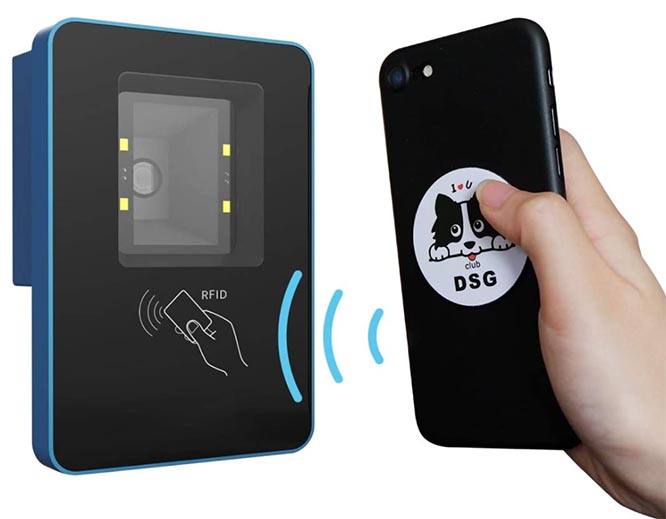
What’s Special About 125kHz?
As we mentioned, there are many different types of RFID cards and fobs. Perhaps the most important difference, though, is the difference in frequency. Different frequencies are used for different purposes, and have different applications. Some are used in industry. Others are used for livestock management, or wildlife tracking. But the ones we’re dealing with today are the ones you use for opening doors and gates. Almost without exception, these utilize the 125kHz frequency. So, why is that?
125kHz falls in the middle of the low frequency radio band, sometimes called the LF band. This band encompasses frequencies of between 30 and 300kHz. That said, the LF band is used for many different purposes. As a result, RFID tags in this range are restricted to 125-134kHz.
The advantage of using a low frequency is that you have a correspondingly long wavelength. In this case, you’re talking about a wavelength of about 2,400 meters. That’s almost a mile and a half! Because of this long length, the waves can pass through metal, and even water. You won’t get that kind of penetration with high frequency (HF) or ultra high frequency (UHF) bands. That said, the useful range of the signal is actually pretty short. At most, your tag will be readable from around 18 inches away. That’s because the RFID tag needs to magnetically pair with the reader in order for the signal to be read.
Magnetic coupling is a way to make a useful RFID tag without a built-in power supply. A powered magnet in the reader generates a small current in the tag. It’s just a tiny current, but it’s enough to generate a signal. At that point, the card or fob can be read, and your door will unlock. Magnetic coupling allows RFID technology to be very small. It also allows your cards or fobs to last indefinitely. If they had to rely on an internal battery, the battery would run out, and you’d have to replace it. On the downside, the technology itself costs a bit more than powered HF or UHF RFID tags.
One common alternative is an antenna-based system, with little antennas on your tags. This can be useful for certain niche applications. However, it’s expensive, and a single antenna reader can cost over a thousand dollars. In addition, these kinds of tags don’t have any security standards. In other words, they’re not useful for locks, or for any other security-related applications.
What About 13.56MHz?
Along with 125kHz cards and fobs, the other frequency you’re likely to encounter is 13.56MHz. This is a shorter-range signal, with a maximum range of less than a foot. Because of the short range, these RFID cards are inherently more secure. There’s simply no chance of them being scanned from across the room. For this reason, the 13.56MHz band is popular for applications that require more security. It’s the frequency of choice for library cards, bus passes, and many contactless payment cards. The 125kHz band, on the other hand, is more commonly used for access cards and fobs.
One thing to be aware of is that the frequency impacts the effectiveness of RFID blocking sleeves. These sleeves use an internal mesh that’s designed to protect against 13.5MHz and higher 860-960MHz frequencies. Inside a properly-designed sleeve, 13.56MHz access cards simply won’t work. On the other hand, these sleeves will only have a tiny impact on the effectiveness of a 125kHz signal. You can keep your card inside a sleeve, scan your lock, and it will still work. Just keep in mind that this works both ways. A sleeve will keep your payment info from getting stolen, but not your door scanner.
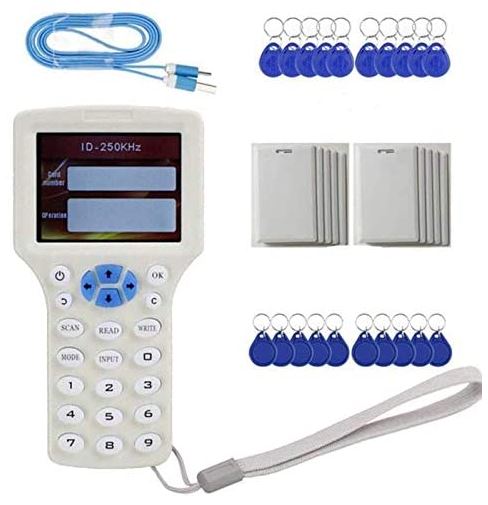
SYWAN RFID Copier
The SYWAN RFID Copier is bigger and beefier than the WILSHIN. It has a white housing, which is wide enough for a full numeric keypad on the front of the handle. Towards the top, the housing flares out to accommodate a color LCD display. This display gives you plenty of feedback, so you can easily understand what you’re doing.
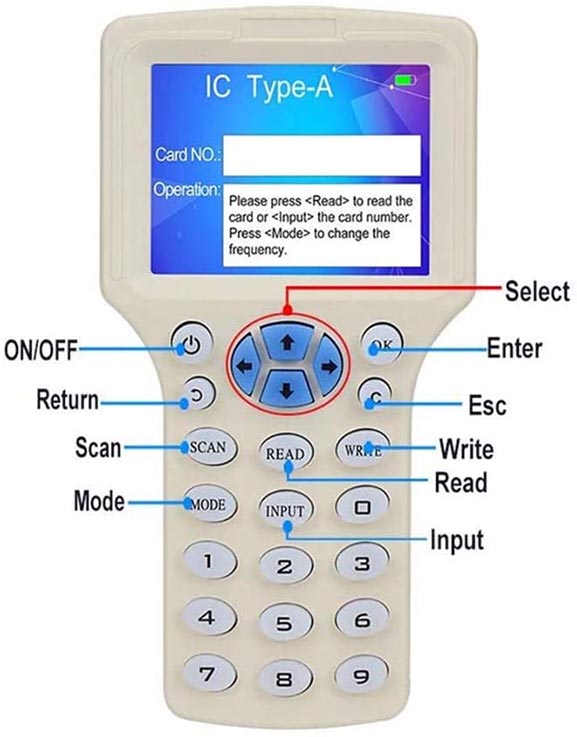
This copier will copy most unencrypted and partially-encrypted 125KHz and 13.56MHz RFID cards. The kit actually includes ten 125KHz cards, ten 125kHz key fobs, and ten 3.56MHz fobs. It’s powered by four AAA batteries, which will last through hundreds of copying cycles. If for some reason you don’t have batteries, you can also plug it into a USB power supply.
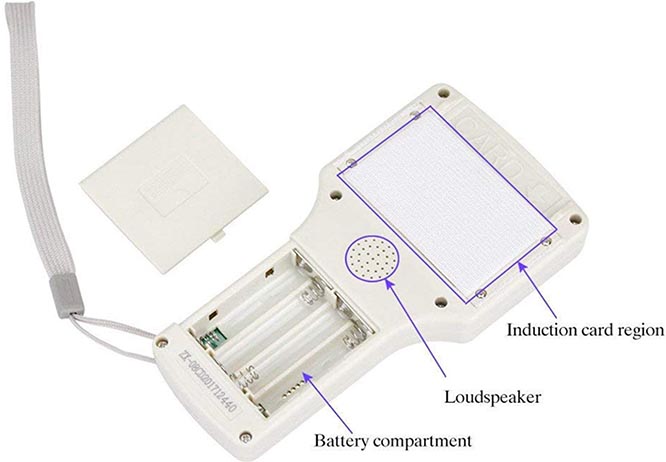
Copying an unencrypted card or fob is easy. Press the power button, and you’ll see a disclaimer. Press “Ok,” not “Confirm,” and you’ll be able to proceed. Put your card on the sensor, and press the scan button. When the scan is complete, you’ll see the card number and frequency on the display. At that point, put your blank card or fob on the sensor, and press the write button. As soon as the process is complete, you’ll see a confirmation method.
Copying a partially-encrypted card is a little more involved. When you read the card, you’ll see a message telling you to connect to a computer. For this, you’ll have to connect via USB, and you’ll only be able to use a Windows PC. If it’s your first time, you’ll have to insert the CD into your computer, and run the install software. Once that’s done, you’ll be able to start decoding. This normally takes about 10 to 20 minutes, so feel free to grab a sandwich. Once the decoding is complete, create your new card as normal.
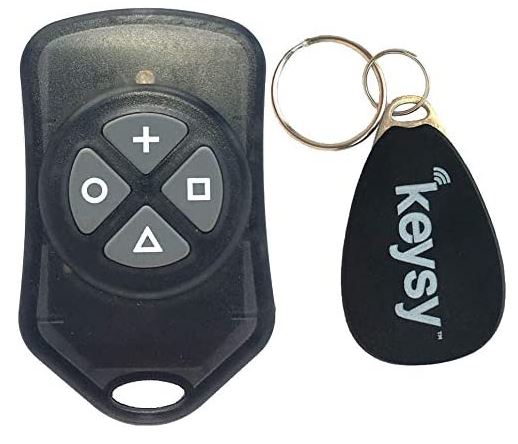
Keysy RFID Duplicator
The Keysy RFID Duplicator is a small, handheld fob that looks like a little keychain car controller. The front has four rubber buttons, which are easy to operate. It can read most 125kHz cards, although you should check the guidelines to be sure. For example, it won’t copy iClass cards.
As far as copying goes, the performance is a bit of a mixed bag. It works quickly and easily, but it only copies to Keysy’s branded key fobs and cards. There’s a single card included in the kit, so you have something to start out with.
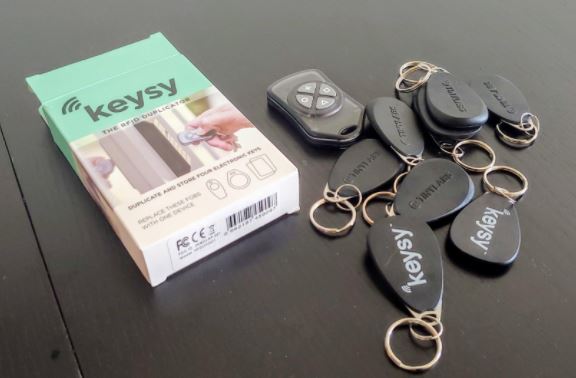
That said, the Keysy duplicator has a trick up its sleeve. Using the on-board memory, you can store the information for up to four cards and fobs simultaneously. Then, you can use the duplicator as if it were a fob.
Final Verdict
As you can see, each of these RFID key fob card copiers has its own strengths and weaknesses.
The Keysy RFID Duplicator is a bit of an oddball. On the one hand, you can only copy to Keysy branded cards and fobs. This naturally limits its usefulness. On the other hand, you can store up to four cards in memory. If you want a programmable fob that can be used for multiple purposes, this is a solid choice.
The SYWAN RFID Copier, on the other hand, is the most versatile. In addition to unencrypted 125kHz cards, it can also copy partially-encrypted cards with the aid of a Windows PC. There’s a bit more of a learning curve here, depending on what you’re copying. Then again, you can copy most 125kHz and 13.56MHz cards.
The WILSHIN RFID Card Reader Writer is the easiest to use, as well as the most affordable. If you’re looking for a foolproof copier, you’ve found it. Then again, you can only copy a limited type of 125kHz card.
Meet Ry, “TechGuru,” a 36-year-old technology enthusiast with a deep passion for tech innovations. With extensive experience, he specializes in gaming hardware and software, and has expertise in gadgets, custom PCs, and audio.
Besides writing about tech and reviewing new products, he enjoys traveling, hiking, and photography. Committed to keeping up with the latest industry trends, he aims to guide readers in making informed tech decisions.

